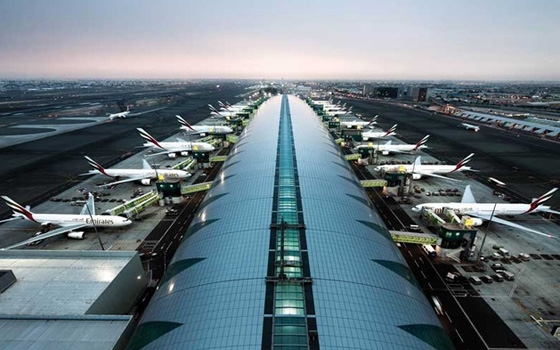The global airline industry has forecast a modest improvement in global net profits for 2013.
The International Air Transport Association (IATA) now expects airlines to produce a combined net post-tax profit margin of 1.6 percent (up from the previously forecast 1.3 percent) with a net post-tax profit of $ 10.6 billion (up from the previously projected $ 8.4 billion).
It said Middle Eastern airlines are expected to add 12.8 percent in capacity in 2013 and this will be outpaced by demand growth of 13.7 percent.
Middle Eastern airlines are expected to post a profit of $ 1.4 billion this year. This is up slightly from the $1.1 billion previously forecast and stronger than the $ 900 million profit recorded in 2012.
The growing role of the region's airlines in providing connectivity to developing markets is reflected in strong traffic growth.
The region's carriers rank third in terms of operating profitability with an Earnings Before Interest and Taxes (EBIT) margin of 3.4 percent, after Asia-Pacific (5.3 percent) and North America (4.1 percent). IATA also cautioned about rising fuel prices.
Tony Tyler, IATA director general and CEO, said $130 per barrel of jet fuel now seems likely for the remainder of the year, adding $ 6 billion to the $ 210 billion fuel bill for 2013 that airlines had expected.
He says continued financial turmoil in the euro zone also presents "a very significant risk" to airlines' profitability.
"Industry profits are taking a small step in the right direction. Against a backdrop of improved optimism for global economic prospects passenger demand has been strong and cargo markets are starting to grow again.
The economic optimism is also pushing fuel prices higher. We are seeing a $12 billion improvement in revenue, and a $9-10 billion increase in costs– most of which is related to fuel," said Tyler.
Confidence in the airline industry is rising around several factors:
GDP growth forecasts for 2013 have been upgraded to 2.4 percent, a significant improvement from the 2.1 percent in 2012.
It appears that the bottom of the global industrial production cycle was reached in the third quarter of 2012 after which there has been six months of increasing output and improvements to business confidence.
There is a structural improvement in the airline industry's financial performance as recognized by a 7 percent increase in share prices since the beginning of the year, despite a 5 percent increase in fuel costs.
IATA noted that considerable risks remain which could derail recovery. The outlook is based on evidence of growing business confidence. But the controversy over the draconian bailout proposal for Cypriot financial institutions is a clear indicator that the Eurozone crisis is not over and could take a turn for the worse.
Forecast Highlights
Stronger Revenue: Stronger revenues ($ 671 billion, up $ 12 billion from the December outlook) are the main driver of the slightly improved financial performance. Cargo demand is expected to grow by 2.7 percent (reversing the declining trend of the last two years) and cargo yields are expected to be flat (an improvement on the 1.5 percent decline previously projected). Passenger demand is forecast to grow by 5.4 percent (up from the 4.5 percent previously expected) and yields are expected to grow by 0.4 percent (rather than the 0.2 percent decline previously projected).
Cash flow: Airline cash flows are showing better than expected performance given high costs and weak growth.
Efficiency: A comparison of 2013 conditions and expected profitability to those of 2006 reveals significant gains in efficiency. The industry aggregate operating margin in both years was similar (3.2 percent in 2006 and 3.3 percent is expected for 2013) but conditions in 2013 are much more difficult.
"The improvements in industry profitability are encouraging. But they must be kept in perspective. We are projecting that airlines will make a net profit of $10.6 billion on $671 billion in industry revenues. By comparison last year Nestle, a single company, made over $11.5 billion in profit on revenues of about $100 billion. Chronic anemic profitability is characteristic across most of the aviation value chain when compared to other sectors. It will require more than improving economic conditions to fix. Neither the challenges nor the benefits of doing so should be underestimated," said Tyler.
Aviation is a catalyst for economic growth and development that supports some 57 million jobs and $2.2 trillion in economic activity.
"The improved outlook despite the difficult operating environment demonstrates the efficiencies and improvements achieved as the industry has restructured itself over the last decade. But too often governments throw us curve balls. In the last weeks we had some unpleasant reminders. Europe announced proposals for passenger rights legislation that will add costs to flying, but with little or no long-term benefit to consumers. The US budget sequestration will see cuts to air traffic management, security and border control that may cost more economically than the benefit of the cost savings achieved. And the UK's Air Passenger Duty– the highest aviation tax in the world– will increase again on 1 April. Airlines don't want special treatment, but they do need a joined-up policy framework that enables them to meet the growing needs for connectivity sustainably. With a 1.6% net profit margin, there is very little buffer between profit and loss," said Tyler.
Arab News
21 March








































































